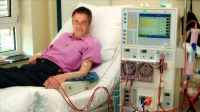soma intimates reno nv
High-dose hemodiafiltration (HDF) produced substantially better survival compared with conventional, high-flux hemodialysis in people with end-stage kidney disease (ESKD) in CONVINCE, a randomized, how to take 20mg of lexapro multicenter trial of 1360 patients treated for a median of 30 months.
The results show that high-dose HDF, with a convection volume of greater than 23 L/session, improved overall survival by 23% compared with hemodialysis, a significant difference for the study’s primary endpoint, Peter J. Blankestijn, MD, PhD, said at the European Renal Association Congress.
The results were simultaneously published online in the New England Journal of Medicine.
“This is the first time in decades that a change in the basic concept of dialysis proved to be clinically meaningful, and that’s pretty cool,” said Blankestijn, a nephrologist at the University Medical Center in Utrecht, The Netherlands.
Although the findings show a resounding added benefit from HDF, the treatment — which has had little US uptake until now — may remain unavailable to most patients given the tight budgets faced by US centers that provide dialysis, said one expert.
Cost a Barrier in the US
Although hemodialysis — the most common form of dialysis used in the treatment of kidney failure — has improved over the years, it is not good at removing larger molecules from the blood, relying as it does on membrane diffusion, the passage of uremic toxin molecules across a membrane that is driven by concentration differences.
Hemodiafiltration is a newer technology that relies not only on diffusion but also introduces convection, allowing for more efficient removal of larger and medium-sized water-soluble molecules. But it is not suitable for all patients because it requires a higher blood flow rate to be effective.
Existing hemodialysis machines are not designed to deliver high-dose hemodiafiltration, so pivoting to HDF would require either wholesale replacement of most existing US dialysis infrastructure or retooling it to deliver HDF by adding new pump systems, commented Jay B. Wish, MD.
Another incremental cost for HDF is the special fluid treatment it employs.
Because most US patients have their dialysis treatments paid for by Medicare, and because those reimbursements are capped at levels that barely cover the cost of conventional hemodialysis, “I don’t think there is any wiggle room to cover the incremental cost” of HDF, said Wish, who is medical director of the out-patient dialysis unit at Indiana University Hospital in Indianapolis, in an interview.
“I’d be shocked if we see more [US] adoption of HDF, given the current economic structure, even with a 23% relative risk reduction in all-cause death,” Wish declared.
HDF uptake has been much more robust in Europe, where a “significant minority” of patients with ESKD have already been receiving HDF treatment, he noted.
Previous studies have failed to conclusively prove that high-dose hemodiafiltration is more effective than conventional hemodialysis, but these new findings have changed this.
“During my career, I’ve watched new treatments emerge for many diseases, from diabetes to cancer, but we haven’t seen the same advances in the treatment of chronic kidney disease,” said Andrew Davenport, MD, University College London (UCL) Medicine and the Royal Free Hospital, London, UK, a senior author of the CONVINCE trial.
“This study proves that targeting different molecules through [high-dose] hemodiafiltration has clear benefits for patients. I would say that this is the first major step forward in many years and is good news for kidney disease patients and their families,” added Davenport, in a press statement from UCL.
A European Trial
CONVINCE included randomized adults with ESKD who had been on hemodialysis for at least 3 months and were candidates for high-dose HDF at 61 centers in eight European countries. Enrollment ran from October 2018 to March 2021, followed by at least 24 months of treatment on the assigned intervention. The primary endpoint was death from any cause.
The results showed a mortality rate of 7.1/100 patient-years with HDF and 9.2/100 patient-years with hemodialysis.
Death from any cause occurred in 118 patients (17.3%) in the hemodiafiltration group and 148 patients (21.9%) in the hemodialysis group (hazard ratio [HR], 0.77; 95% CI, 0.65 – 0.90).
Noncardiovascular deaths, including a substantial number of deaths attributed to COVID-19 infection, were also significantly reduced with HDF treatment.
The between-group difference in mortality became apparent within the first year of treatment and further expanded over time.
But the risk of death from cardiovascular causes (HR, 0.81; 95% CI, 0.49 – 1.33) and the composite outcome of fatal or nonfatal cardiovascular outcomes (HR, 1.07; 95% CI, 0.86 – 1.33) were similar in the hemodiafiltration and hemodialysis groups.
Another senior study author, Matthias Rose, MD, PhD, Charité University, Berlin, Germany, noted: “In addition to clinical events, patient perception, and thus, reported outcomes are very important.”
We are currently performing in-depth analyses of the extensive data on patient-reported outcomes that have been collected in the CONVINCE study, with results expected later this year,” Rose said in the UCL statement.
The study received no commercial funding. Blankestijn and Wish have reported no relevant financial relationships.
N Engl J Med. Published online June 16, 2023. Abstract
ERA Congress. Presented June 16, 2023.
Mitchel L. Zoler is a reporter for Medscape and MDedge based in the Philadelphia area. @mitchelzoler
For more news, follow Medscape on Facebook, Twitter, Instagram, YouTube, and LinkedIn.
Source: Read Full Article
